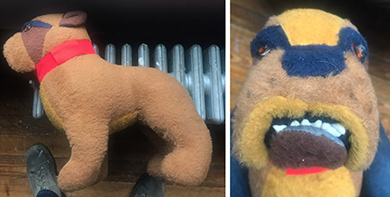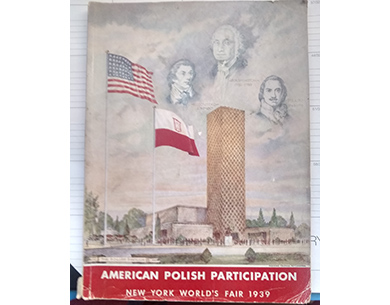 |
|
|||
 |
 |
|||
RINKER ON COLLECTIBLES — Column #1777 Copyright © Harry Rinker, LLC 2021 Questions
and Answers
QUESTION: I have a plush, standing Mack Truck bulldog. One cloth label reads: “DESIGNED EXCLUSIVELY FOR MACK TRUCKS.” A second cloth label has two Big Top tent silhouettes above “Animal Fair, Inc. / Chanhassen, Minn © / 55317 / HAND WASHABLE” beside which is a text block that begins with “CONTENTS: / ALL NEW MATERIAL / SHREDDED SYNTHETIC / FOAM.” The bulldog has a light brown (tan) body, a yellow crown on its head, blue eyes, nose, and mouth, and a red ribbon around its neck. I believe it is scarce. Can you tell me when it was made, what the production run was, and how much it is worth? – Email Question, PA 
ANSWER: Let’s start with the basics. “55317” is the Zip Code for Chahassen, Minnesota. Zip Codes were introduced on July 15, 1963. Your stuffed toy was made after this date. Mack Truck celebrated its 75th anniversary in 1975. Although I found no confirming evidence on the Internet that your stuffed Mack Bulldog was part of the 75th anniversary souvenirs Mack Truck created, the concept remains in the “realm of possibilities.” A February 1, 2017, article by Richard Crawford entitled “Stuffed toys were made in Chanhassen, ‘By George!’” notes that George Grooms, an artist who worked for Collegiate Manufacturing in Ames, Iowa, founded Animal Fair, Inc., in 1960. Animal Fair, Inc., would produce thousands of George’s plush animal creations. Animal Fair, Inc., was located on 78th Street in Chanhassen in a building that now serves as the High Timber Lodge that is part of Country Inn and Suites. Girl Scout troops and school groups raised funds by selling stuffed plush animals created exclusively for them by George Grooms. Henry the Dog, with a small storybook attached to his neck, and an assortment of furry animal friends were Animal Fair, Inc.’s top sellers. In the 1970s, George Grooms sold Animal Fair, Inc., to Guy Shoennecker. He gradually moved the majority of production to China. China created the “skins” which were sent to an Eden Valley, Minnesota plant to be stuffed. The showroom and warehouse in Chanhassen closed in the 1980s. Your plush Mack bulldog dates between the late 1960s and the mid-1970s. No manufacturer or retailer ever releases production run information. My best guess is that production ranged from the mid-hundred to low thousands. As a result, your stuffed Mack bulldog is common rather than scarce. Determining how it was distributed requires additional research. It may have been a giveaway to a person who visited a showroom to look at a Mack truck or purchased a new truck. Mack also sold advertising merchandise. A search on WorthPoint.com revealed 74 listings for “Mack Truck stuffed bulldog.” The majority sold through on eBay between $15.00 and $30.00. I did not find an image that exactly matched your bulldog in this search. Using “Animal Fair Mack bulldog” as a search string, I found a 1971 Animal Fair Mack bulldog. It was not a match to your plush Mack bulldog. The fact that I was unable to find an exact match does not discount the fact that your plush Mack bulldog is common. It has a secondary market value between $20.00 and $25.00. QUESTION: I recently purchased a codfish weathervane for $170.00 from the estate sale of a New England antiques dealer. The seller told me the codfish weathervane dates from 1900. The weathervane appears to be made from copper and painted over (rather roughly) with serval coats of gold paint. The previous owner added a heavy, more modern iron display base. The piece displays nice, and I have no intention of selling it. I would appreciate your thoughts on its authenticity, age, and approximate value. – Email Question, BB 
ANSWER: Let’s begin with a question you did not ask: “Did the seller lie about the age?” The answer is yes. Your weathervane is a 1960s decorator reproduction. It was made from molded copper. I found several unpainted and painted examples when I searched WorthPoint.com. It is common for sellers to paint and otherwise falsely age reproductions (exact copies) and copycats (stylistic copies) to allow them to suggest (a polite term on my part) an older date of origin. My guess is that the only place this weathervane ever appeared was in an owner’s den or living room. I wish more of my readers would tell me what they paid for something when sending me a question. Knowing the sale price allows for a high degree of interpretation. First, the sale price should have set off an alarm bell. An almost 125-years old period weathervane, especially one that exhibits outdoor use, does not sell for $175.00. The asking price was a clear indication the seller knew the piece was much later. Second, WorthPoint.com has multiple listings for identical codfish weathervanes. Prices range from $100.00 to $150.00. One of the criteria of a “fair price” is a willing buyer and willing seller. You were a willing buyer and the seller was willing to sell to you. Since there are no fixed prices for antiques and collectibles, the $170.00 you paid was “fair” at that moment in time. You paid slightly over the secondary market retail. Since you bought the codfish weathervane for display purposes and have no intention of selling it, my suggestion is to forget what you paid and simply enjoy the piece. QUESTION: I have a souvenir booklet entitled “AMERICAN POLISH PARTICIPATION / NEW YORK WORLD’S FAIR 1939.” It is over 100 pages in length. The colored cover shows one of the fair buildings and features the American and Polish flags. What is it worth? – Email Question, SB, Lansdale, PA 
ANSWER: The Polish Pavilion at the 1939 World’s Fair was located in the Government Zone. Jan Cybulski and Jan Galinowski were the architects. Poland spent approximately one million dollars on the building’s construction. Its 70,000 square feet included space for 11,000 exhibits. The Polish Pavilion opened on May 3, 1949, and marked the 148th anniversary of Poland’s first constitution. The Court of Honor featured documents that stressed Poland’s democratic traditions. Another section called attention to Poland’s contributions to the settling of the United States. The building’s Hall of Science featured more than 200 Polish inventions and also stressed its maritime development. A bar, café, and deluxe restaurant were in a separate building. The site also contained a bronze statue replica of King Ladislaus II Jagiello by Stanislaw K. Ostrowski, a sculptor, housed on a pedestal at the pavilion’s entrance. The Polish government in exile presented the statue to the City of New York in 1945. It is now located in New York’s Central Park. The Polish pavilion’s murals are currently housed at Le Mayne College in Syracuse, New York. On September 1, 1939, Germany invaded Poland. A day later over 10,000 members of the Polish National Alliance gathered at the Polish Pavilion to express their support for a free and independent Poland. The Polish government in exile kept the Polish Pavilion open for the 1940 season. When the New World’s Fair ended in autumn 1940, the Polish government in exile sent most of the artifacts to Chicago for storage in the Polish Museum of America. The pavilion itself was torn down. Despite this great story, there is little collector interest in your booklet. Further, your copy is in fair to good condition. As such, its secondary market retail value is between $8.00 and $12.00. QUESTION: Do old high school, college, law school, and nursing school diplomas and baptismal certificates dated from the mid- to early 20th century have any value? – Email Question, NP, West Chester, PA ANSWER: With the exception of family value, which is not a monetary value, the answer is basically no. The possible exceptions are: (1) diplomas and baptismal certificates that belong to a person of nationla importance [valuable because of the name connection] or a major resident of a local community [possible value to a local historical society who will want them as a donation as opposed to buying them], (2) have a large vignette of an actual building associated with the institution issuing the diploma [of minor value to a local collector, a few bucks each at most], and (3) printed by a collectible lithograph company such as the American Banknote Company [a long shot at best]. Offer them first to the family. If no takers, try the local historical society. If this fails, contact the librarian at each of the institutions [another long-shot]. If these three avenues fail, consider the landfill. Harry L. Rinker welcomes questions from readers about
collectibles, those mass-produced items from the twentieth and twenty-first centuries.
Selected letters will be answered in this column.
Harry cannot provide personal answers.
Photos and other material submitted cannot be
returned.
Send your questions to: Rinker on Collectibles, 5955 Mill
Point Court SE, Kentwood, MI 49512.
You also can e-mail your questions to
harrylrinker@aol.com.
Only e-mails containing a full name and mailing address
will be considered.
|
||||